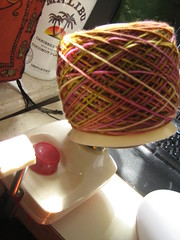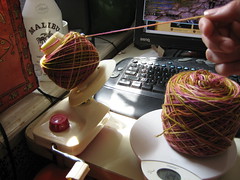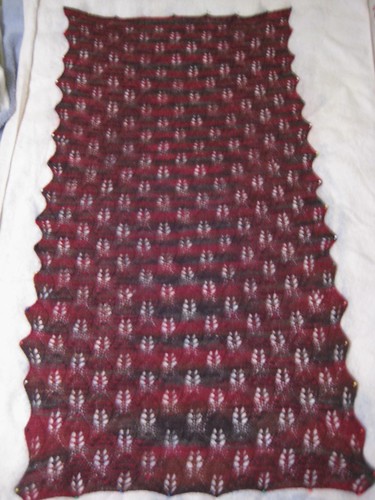I have joined a few sock clubs and have bought other small skeins of yarn to add to my stash of sock yarn. Often times, it is sold in small skeins, but more often it is sold in one huge 350-500 super skein. Because of my whole symmetry thing, I prefer to knit pairs of things at the same time on two circular needles (good how-tos can be found here and here). It's fine if the yarn is all one color (then you can knit from the outside strand and the inside strand), or if you have two small skeins (like the ones knitpicks sell). However, things get tricky if you are working with a hand-painted single skein. I personally want the colors to match up and go in the same order, which wouldn't happen if you just knit from opposite ends of the yarn.
 Here is my method. First, I take the skein and put it onto a swift. I found mine on ebay for about $20-30.
Here is my method. First, I take the skein and put it onto a swift. I found mine on ebay for about $20-30.
Next, start to wind the skein into one huge ball. I have a cheap ball winder that I got at Joann.com for about $20 or so. It gets the job done, so money well spent. It takes all of 3-6 minutes to wind a whole skein.
Once you have the entire skein in a ball, take it off the ball winder, and put it on a scale. The more accurate, the better. I have one that can weigh in grams, which is a lot more precise than ounces. I think I got mine for about $20 (sense a theme?) from a website that sells soap-making supplies. Always go with what's on the scale rather than what the
 manufacturer lists. For example, the label lists this as 155g, but in according to my scale it is 172g. Make sure you write it down! It's easy to get distracted and forget.
manufacturer lists. For example, the label lists this as 155g, but in according to my scale it is 172g. Make sure you write it down! It's easy to get distracted and forget. Once you have the weight, pull the end from the center and put that onto the ball winder to make your second ball. Keep the original ball on the scale. Start winding away, noting the weight as it goes down. I would also recommend holding the yarn loosely between your fingers to not only add a bit of tension, but to help keep the ball on the scale.
Once you have the weight, pull the end from the center and put that onto the ball winder to make your second ball. Keep the original ball on the scale. Start winding away, noting the weight as it goes down. I would also recommend holding the yarn loosely between your fingers to not only add a bit of tension, but to help keep the ball on the scale. Once the scale approaches half of your original weight, you can clip the yarn. Since I have that whole symmetry thing, I compare the color on the center-pull of the new ball to the halfway area between the two balls. This way, the two socks/sleeves/gloves will have approximately similar color changes in the same places.
Once the scale approaches half of your original weight, you can clip the yarn. Since I have that whole symmetry thing, I compare the color on the center-pull of the new ball to the halfway area between the two balls. This way, the two socks/sleeves/gloves will have approximately similar color changes in the same places. Ta da! That is pretty much it. Now you should have two balls of about the same length and weight. It's not totally scientific, and I doubt highly that it's 100% accurate. For that reason, I'd say to not use a pattern that is cutting it close in terms of yardage. If you have a pattern that requires 420 yards, and you have 400-410 yards that you just split into two balls, I'd skip it and go with a pattern than requires fewer yards. I'd personally would have a conniption fit if one sock came up a few yards short!
Ta da! That is pretty much it. Now you should have two balls of about the same length and weight. It's not totally scientific, and I doubt highly that it's 100% accurate. For that reason, I'd say to not use a pattern that is cutting it close in terms of yardage. If you have a pattern that requires 420 yards, and you have 400-410 yards that you just split into two balls, I'd skip it and go with a pattern than requires fewer yards. I'd personally would have a conniption fit if one sock came up a few yards short!

